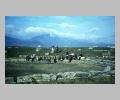
"Fountain house" behind the Church of Agia Fotini, Mantinea.

Church of Agia Fotini, Mantinea.

View of the theater (5th-4th Century B.C.E.), Mantinea.
| Summary: | A rival of Tegea as the most important Arkadian city. |
| Type: | Fortified city |
| Region: | Arcadia |
Periods:
Geometric
Archaic
Classical
Hellenistic
Roman
Physical:
Located ca. 12 km NE of modern Tripolis on the upland plain, Mantinea occupied the area of 5 smaller villages that had synoicized at an uncertain date (cf. Tegea). The oldest section of the city was centered on the Gortsouli (ancient Ptolis) hill.
In the 4th century B.C. the city was rebuilt and new city walls, ca. 4 km in length, were built with over 100 towers and 9 or 10 gates. The course of the river Ophis was altered to provide additional defense. The city walls are among the best fortifications of Classical Greece and may have been designed by the same Thebian engineer who planned the walls of Messene. The city had a Temple of Hera and a colonnaded agora with a theater at its W end.
Description:
Already mentioned in Homer's Iliad, Mantinea of the Classical period was a synoicism of 5 smaller villages. It was one of the most important of Arkadian cities and a rival of Tegea. Mantinea was allied with Sparta until the Peloponnesian War when it sided with Athens.
In 385 B.C. Sparta destroyed Mantinea and dispersed the inhabitants. In 371 B.C. the city was rebuilt with new fortification walls and repopulated. In 370 B.C. Lykomedes of Mantinea instigated the foundation of the Arkadian League, but in 364 the city left the league to form a new alliance with Sparta.
In 222 B.C. the city revolted against Macedonian control and suffered destruction by Antigonos Doson, who then rebuilt the city and renamed it Antigoneia, a name that it retained until the 2nd century A.D.
Exploration:
Excavations by the French School directed by G. Fougères and V. Bérard in 1887-1889.
Sources Used:
Other Bibliography:


